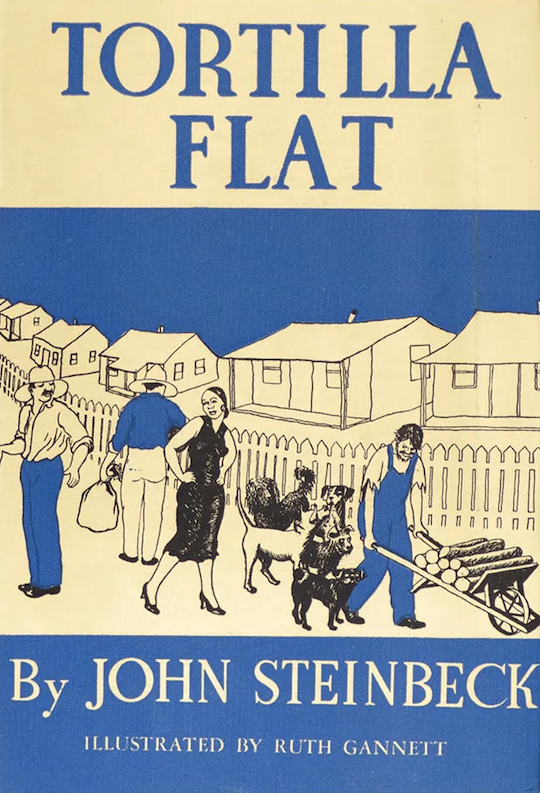STEINBECK AND "THE HARVEST GYPSIES"
PACIFIC GROVE, CA — SEPTEMBER 1936 — From a small shack near the ocean, a young novelist looks homeward. “There are riots in Salinas,” he writes a friend, “and killings in the streets of that dear little town where I was born.”
Salinas is up in arms — gunshots, tear gas, explosions. Another strike, another struggle for survival in what TIME calls “America’s salad bowl.” But the press is ignoring the larger picture, so after finishing a novel he calls Something That Happened, (later retitled Of Mice and Men) John Steinbeck sets out in an old bakery truck to get to the heart.
Ever since dry winds and drought turned the Midwest into a Dust Bowl, some 150,000 “Okies” have come West. Now they roam the Golden State, harvest to harvest, living in squalor, struggling, starving, dying. And The San Francisco News wants Steinbeck to write about these “harvest gypsies.”
Steinbeck is an unlikely reporter. Though he wrote briefly for a Brooklyn paper, he has spent the last decade honing a novelist’s craft. His first novel was ignored, but Tortilla Flat showed promise. And In Dubious Battle displayed his gift for describing the hardscrabble life of migrant labor. Six articles, The News requests. Fifteen thousand words.
Heading north through the San Joaquin Valley, Steinbeck visits the Gridley Camp outside Sacramento. One of two government camps in the state, the facility is clean, almost comfortable. But when he turns south, into cotton country, he is appalled.
He sees migrant camps that look like “a city dump.” He meets families, a dozen people or more, squatting in shacks with no beds, no electricity, no running water. He sees children with swollen bellies, flies around their eyes. He sees anger brewing.
“There is a crime here that goes beyond denunciation,” the novelist will later write. “There is a sorrow here that weeping cannot symbolize. There is a failure here that topples all our successes. . .”
But the novel will come. First, the journalist gets busy. Steinbeck interviews families who lost everything to the dust. “Five years ago this family had fifty acres of land and a thousand dollars in the bank. . . Now they have one quilt and a piece of canvas for bedding.”
His beloved California is a powder keg. “When they need us they call us migrants,” one boy tells Steinbeck, “and when we’ve picked their crop, we’re bums and we got to get out.” Police and vigilantes crack down, cracking skulls, rounding up “Commies,” using tactics Steinbeck can only call “fascistic.”
After a month in the fields, Steinbeck returns to his new house in Los Gatos. Telling the facts about what he has seen is easy. In five days, he bangs out the 15,000 words. But the newspaper sits on the articles.
“The labor situation is so tense just now,” Steinbeck writes a friend, “that The News is scared and won’t print the series. Any reference to labor except as dirty dogs is not printed by the big press out here.”
Then in early October, with photos by Dorothea Lange, The News publishes “The Harvest Gypsies.” And. . . Nothing happens. No call to arms. No action on Steinbeck’s suggested solutions. He will have to find a bigger canvas.
First he tries a “rather long novel” he calls The Oklahomans. It stalls. He goes back to the fields, sees people “not just hungry but actually starving.” Back home, he writes a novela, but judges it “a bad book and I must get rid of it.”
Then in May 1938, exhausted, angry, inspired, he tries one more time. He has a fictional family in mind now. The Joads. And a preacher friend of theirs. And a title, given by his wife, Carol. This time, the prose flows in cadences almost Biblical.
“To the red country and part of the gray country of Oklahoma, the last rains came gently, and they did not scar the earth. . .”
Over the next six months, writing every day, keeping a journal about how the writing is going, Steinbeck finishes his mighty book. The best-selling Of Mice and Men made him comfortable, but The Grapes of Wrath made history.
Made into a movie, a play, songs by Woody Guthrie (and later Bruce Springsteen), the saga of the Joad family made America pay attention. “I've done my damnedest,” Steinbeck told his editor, “to rip a reader's nerves to rags.”
The Grapes of Wrath was burned, banned, but read by pretty much everyone who read books in 1939. Among the readers was Eleanor Roosevelt. In her newspaper column, “My Day,” the First Lady wrote: “The horrors of the picture, so well drawn, make you dread sometimes to begin the next chapter, and yet you cannot lay the book down or even skip a page.”
The war came and the Depression ended. The “Okies” settled into California, as Steinbeck knew they would. And with time, new migrants came to pick crops.
California’s “Pastures of Plenty” still require migrant labor. And though conditions have improved, Steinbeck’s warnings still echo across America’s salad bowl.
“In the eyes of the hungry there is a growing wrath. In the souls of the people the grapes of wrath are filling and growing heavy, growing heavy for the vintage.”


















